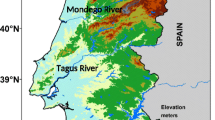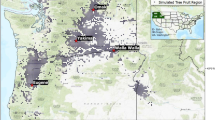Abstract
Most deciduous fruit trees need sufficient accumulated chilling, or vernalisation, to break winter dormancy. Inadequate chilling due to enhanced greenhouse warming may result in prolonged dormancy, leading to reduced fruit quality and yield. The potential impact of warming on chill accumulation has been analysed using the Utah vernalisation model and temperature data from over 400 climate stations in southern Australia. Two experiments were performed: (i) a sensitivity study where temperatures were increased at all sites by either 1, 2 or 3 °C; (ii) a scenario study for the year 2030 where temperatures were increased according to spatially- and seasonally-varying warming scenarios derived from five global climate models under enhanced greenhouse conditions.
The sensitivity study shows that warming causes greater reduction in chilling at sites with a higher present mean temperature and/or a wider diurnal temperature range. In the scenario study, two warming scenarios for the year 2030 were considered: a low (high) warming scenario which assumes a low (high) rate of increase of greenhouse gas emission, a low (high) global climate sensitivity to increased emissions, and a low (high) regional temperature response. The low warming scenario is less than 1 °C in southern Australia and is unlikely to affect the vernalisation of high-chill fruit, except for pome-fruit grown in south-west Western Australia. The high warming scenario exceeds 1.5 °C and would significantly increase the risk of prolonged dormancy for both stone-fruit and pome-fruit at many sites.
Similar content being viewed by others
References
Ashcroft, G. L., Richardson, E. A., and Seeley, S. D.: 1977, ‘A Statistical Method of Determining Chill Unit and Growing Degree Hour Requirements for Deciduous Fruit Trees’,Hortscience 12(4, 347–348.
Australian Bureau of Meteorology: 1988,Monthly Weather Review, Western Australia, March-October, National Climate Centre, Melbourne.
Batten, D. and Firth, D.: 1987, ‘Effective Chilling Temperatures’, in Skinner, I. (ed.),Proc. 1st National Low-Chill Stone-Fruit Conference, Lismore, New South Wales, Australia.
Baxter, P.: 1987,Growing Fruit in Australia, Thomas Nelson Publ., Melbourne, Australia.
Bazzaz, F. A.: 1990, ‘The Response of Natural Ecosystems to the Rising Global CO2 Level’,Ann. Rev. Ecol. System. 21, 167–196.
Carbone, G. J. and Schwartz, M. D.: 1993, ‘Potential Impact of Winter Temperature Increases on South Caroline Peach Production’,Clim. Res. 2, 225–233.
Clayton-Greene, K.: (in press), ‘Horticulture: Response to Greenhouse Warming’, in Galbally, I. E. (ed.),Proc. Workshop on Agriculture and Greenhouse in South-Eastern Australia, 18-19 March 1992, CSIRO Division of Atmospheric Research, Melbourne.
CSIRO: 1992,Climate Change Scenarios for the Australian Region, CSIRO Division of Atmospheric Research, Aspendale, Victoria, 6 pp.
Ebert, A., Bender, R. J., Petri, J. L., and Braga, H. J.: 1986, ‘First Experiences with Chill-Unit Models in Southern Brazil’,Acta Horticult. 184, 79-86.
Fishman, S., Erez, A., and Couvillon, G. A.: 1987, ‘The Temperature Dependence of Dormancy Breaking in Plants: Computer Simulation of Processes Studied under Controlled Temperatures’,J. Theor. Biol. 126, 309–321.
Fitzharris, B. B.: 1988, ‘The Effect of Greenhouse Gas Warming on a Region: A Case Study of the Province of Otago’, inClimate Change: The New Zealand Response, NZ Min. Environ., pp. 130-134.
Gilreath, P. R. and Buchanan, D. W.: 1981, ‘Rest Prediction Model for Low-Chilling “Sungold” Nectarine’,J. Amer. Soc Hort. Sci. 106 (4, 426–429.
Hennessy, K. J. and Pittock, A. B. (in press), ‘The Potential Impact of Greenhouse Warming on Threshold Temperature Events in Victoria, Australia’,Int'l J. Climatol.
Houghton, J. T., Callander, B. A., and Varney, S. K. (eds.): 1992,Climate Change 1992: The Supplementary Report to the IPCC Scientific Assessment, Cambridge University Press.
Hutchinson, M. F. and Bischof, R. J.: 1983, ‘A New Method for Estimating the Spatial Distribution of Mean Seasonal and Annual Rainfall Applied to the Hunter Valley, New South Wales’,Aust. Met. Mag. 31, 179–184.
Jones, H. G.: 1983,Plants and Microclimate, Cambridge University Press, Melbourne, pp. 281–282.
Karl, T. R., Jones, P. D., Knight, R. W., Kukla, G., Plummer, N., Razuvayev, V., Gallo, K. P., Lindesay, J., Charlson, R. J., and Peterson, T. C.: 1983, ‘Asymmetric Trends of Daily Maximum and Minimum Temperature’,Bull. Amer. Met Soc. 74 (6, 1007–1023.
Linvill, D. E.: 1990, ‘Calculating Chilling Hours and Chill Units from Daily Maximum and Minimum Temperature Observations’,Hortscience 25 (1, 14–16.
Lloyd, J.: 1990,Potential Impacts of Climate Change on Horticultural Tree Crops, Bureau of Rural Resources Report No. R/3/90, Canberra, 52 pp.
McCreary, D. D., Lavender, D. P., and Hermann, R. K.: 1990, ‘Predicting Global Warming and Douglas-Fir Chilling Requirements’,Ann. Sci. For. 47, 325–330.
Peereboom Voller, C. F.: 1986, ‘Predicting Rest-Breaking: Principles and Problems’,Decid Fruit Grow. August, 302–308.
Pink, B. N.: 1989,Fruit Western Australia, Season 1988–89, Australian Bureau of Statistics, Western Australian Office, East Perth, Catalogue No. 7322.5.
Plumb, T.: 1982,Atlas of Australian Resources, Series 3, Vol. 3: Agriculture, Division of National Mapping, Canberra, 24 pp.
Richardson, E. A., Seeley, S. D., and Walker, D. R.: 1974, ‘A Model for Estimating the Completion of Rest for “Redhaven” and “Elberta” Peach Trees’,Hortscience 9 (4, 331–332.
Richardson, E. A., Seeley, S. D., and Walker, D. R.: 1975, ‘Author's Reply’,Hortscience 10, 561–562.
Salinger, M. J., Kenny, G. J., and Morley-Bunker, M. J.: 1993, ‘Climate and Kiwifruit cv. Hayward 1. Influences on development and growth’,New Zealand Journal of Crop and Horticultural Science 21, 235–245.
Saure, M. C.: 1985, ‘Dormancy Release in Deciduous Fruit Trees’,Hort. Rev. 7, 239–300.
Whetton, P. H. and Pittock, A. B.: 1993, ‘The Growing Consensus in Simulated Regional Climate for Enhanced Greenhouse Conditions: Is There a Palaeoclimatic Analogue?’Quatern Australia 11/1, 81–87.
Whetton, P. H., Fowler, A. M., Haylock, M. R., and Pittock, A. B.: 1993, ‘Implications of Climate Change due to the Enhanced Greenhouse Effect on Floods and Droughts in Australia’,Clim Change 25, 289–317.
Wigley, T. M. L. and Raper, S. C. B.: 1992, ‘Implications for Climate and Sea Level of Revised IPCC Emissions Scenarios’,Nature 357, 293–300.
Author information
Authors and Affiliations
Rights and permissions
About this article
Cite this article
Hennessy, K.J., Clayton-Greene, K. Greenhouse warming and vernalisation of high-chill fruit in Southern Australia. Climatic Change 30, 327–348 (1995). https://doi.org/10.1007/BF01091930
Received:
Revised:
Issue Date:
DOI: https://doi.org/10.1007/BF01091930




